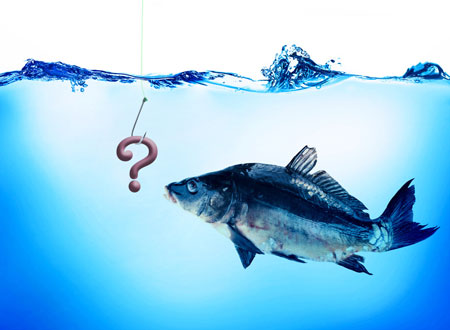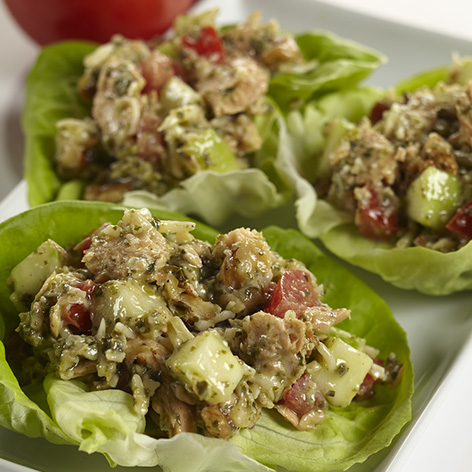Angling for Answers: What Consumers Want to Know about Seafood
From a flaky, melt-in-your-mouth flounder filet, or a dark and oily smoked mackerel, seafood packs a lot of flavor and texture in every bite. It’s heart- and brain-healthy — and if that isn’t enough to jump for joy – it can be easy on the budget, and a time-saving meal option, too.
Although U.S. consumers spent an estimated $86.5 billion on fishery products in 2013, (about 14.5 pounds of edible seafood “meat” per person), Americans still consume only about half of what’s recommended by dietitians, partly due to confusion surrounding it – from safety concerns to practical challenges, such as how to cook it at home. (1)
National Seafood Month, in October, is a great time to educate shoppers and patients about smart seafood choices, and how those choices benefit the health of humans, and just as importantly, ocean habitats
and sea life.
Oldways: In January, the USDA and Health and Human Services released the 2015 dietary guidelines for Americans. What are the current recommendations for seafood? Are there any significant changes in these new guidelines?
Serena Ball: The big news is that the new 2015-2020 Dietary Guidelines encourage Americans to eat seafood in place of other protein foods. The Guidelines specifically name salmon, trout and Pacific oysters as sources of the healthy omega-3 fats DHA and EPA. The tuna sandwich, which is a personal favorite of mine, was mentioned as a good way to increase the variety of protein foods eaten on a weekly basis.
The new Guidelines also specify to eat at least 8 ounces, or two seafood meals per week for better health. This is the same advice as stated in the 2010 Dietary Guidelines, which reinforces the strength of this recommendation. It’s exciting to see the number of nutrition research studies showing the health benefits of eating seafood continue to grow – including benefits for brain and heart health.
OW: Can you bust a few myths about seafood?
SB: A misconception I sometimes hear is that fresh is best; but all varieties of seafood, including fresh, frozen and canned are healthy choices. In general, eating seafood twice a week can reduce the risk of dying from heart disease by about 36 percent. (2)
Among seafood, salmon has one of the highest levels of healthy omega-3 fats (EPA and DHA content) per serving with 700-900 mg per 4-ounce serving. A serving of canned pink salmon also has 20 grams of protein. Including protein at every meal or snack can help a person feel fuller longer and may help maintain a healthy weight. And we know that a healthy weight is linked with a lower risk of high blood pressure, stroke and heart disease.
Occasionally, I hear concerns about mercury. However, many of the most popular fish (like salmon, trout, tilapia, and most shellfish) are low in mercury, so people who eat a variety of seafood (especially choices low in mercury) need not fret.
According to researchers, because seafood is such a rich source of the mineral selenium, the benefits of eating it can outweigh the potential risk. (3)
The real risk is not getting enough seafood. This is especially true for pregnant and nursing moms; babies need the brain-boosting benefits of omega-3 fats. According to the 2015-2020 Dietary Guidelines, pregnant and nursing women should eat a minimum of 8-12 ounces per week of a variety of fish. (4)
The U.S. Environmental Protection Agency states that when women know this information they can make informed decisions about the right amount and right kinds of fish they and their children should eat. (5)
OW: What are some of the misperceptions that consumers have about canned seafood in particular?
SB: I can think of two big ones:
People don’t realize that canned seafood is one of the best nutrition bargains in the supermarket. Canned salmon and tuna have many important nutrients and are an especially easy and inexpensive source of protein. A 5-ounce can of chunk light tuna in water contains a whopping 22 grams of protein with only 100 calories (and the entire can costs two dollar or less) .
Canned shrimp, oysters and crab are also affordable seafood options; they are delicious in ethnic recipes like shrimp pad Thai or Italian pasta with seafood sauce. And talk about convenience: All you have to do is open and serve; top fresh green salads or whole grain rice bowls with canned tuna and more veggies.
Not everyone realizes the simple ingredients found in a can. Take a look at a leading brand of chunk light tuna in water, for example. It contains only four ingredients: Tuna, water, vegetable broth and salt. That’s it!
Additionally, the canning process actually flash-preserves all the great nutrition available in freshly caught fish. Canned salmon and other canned seafood are rich in heart-healthy omega-3 fats.
OW: What do you consider some of the convenient features of canned seafood?
SB: Canned tuna without the can opener: You can now find cans of tuna and salmon with easy open lids. Now people can take the healthy seafood they love with them wherever they go. This simpler way of opening a can of tuna or salmon is in response to consumer demand for greater convenience.
Seafood can also be found in a portable pouch. These portable, no-drain, flavor-fresh salmon and tuna products are terrific, they’re great on-the-go for topping a pasta salad, a bowl of quinoa or a fresh bagel from the local bagel shop.
OW: Why do consumers want to trace the origin of their seafood?
SB: Consumers increasingly want to know the origin of their food for health as well as environmental reasons. Chicken of the Sea, for example, is committed to providing people with as much information as possible about sustainable fishing methods and how their fish was caught — even down to the specific fishing vessel. Seafood lovers can trace their purchase to the specific region and the vessel by which their tuna was harvested by entering the code from their can here: http://www.ChickenoftheSea.com/trace.
OW: What’s your favorite seafood recipe or way to enjoy seafood?
SB: My kids and I like to make Salmon Pesto Lettuce Wraps together.
They are fun to wrap up and fun to eat!
OW: Any suggestions for getting kids to try – and like – eating seafood?
SB: I have four kids – so I have quite a bit of experience in this department!
Start with lighter and sweeter tastes – Canned shrimp and refrigerated/canned crab have lighter, sweeter tastes than darker, oilier fish. Canned seafood is pre-cooked which helps decrease ‘fishy’ aromas that may come from cooking in your kitchen. I mix canned shrimp or crab with plain Greek yogurt and serve it as a sandwich filling or dip with chips. My kids love how the creaminess of the yogurt makes the seafood taste less ‘fishy.’
It’s burger time – Make fish burgers by forming a patty out of a mixture of canned seafood along with grated cooked potatoes, an egg, chopped green onions and a bold spice like curry powder or smoked paprika.
Make fish familiar – Top your family’s favorite recipes with fish. Try serving mild white fish or canned shellfish atop pasta, smothered in tomato sauce and a sprinkle of cheese.
Add ethnic appeal – Today’s kids are traveling and eating in ethnic restaurants more often. So go bold! This doesn’t mean hot spices – but ethnic recipes on Pinterest are a great place to start. My kids like an Asian pasta dish with canned shrimp, soy sauce and veggies like carrots and broccoli.
LINKS TO HANDY RESOURCES
There’s no need to wait until October to start educating people about the health benefits and convenience of seafood, especially when armed with answers to consumer questions and these additional resources:
- For more recipe ideas and information on seafood, Chicken of the Sea has developed this toolkit specifically for health professionals, found on the Oldways website. You’ll find a wealth of information from research to recipes.
- To keep your fresh or frozen seafood choices safe – from selection to storage to enjoyment – check out this handy Consumer Guide to Safe Seafood Handling developed by the Delaware Sea Grant College Program.
- Visit Monterey Bay Aquarium Seafood Watch and the Marine Stewardship Council to learn more about sustainable practices.
- This article from the Academy of Nutrition and Dietetics clearly outlines the types and amount of fish women should eat during pregnancy.
References:
(1) U.S. Department of Commerce | National Oceanic and Atmospheric Administration | NOAA Fisheries, 2013 report
https://www.st.nmfs.noaa.gov/Assets/commercial/fus/fus13/FUS2013.pdf
(2) Mozaffarian D, Rimm EB. Fish intake, contaminants, and human health: evaluating the risks and the benefits. JAMA. 2006;296:1885-99.
(2) Fish: Friend or Foe? Fears of contaminants make many unnecessarily shy away from fish. http://www.hsph.harvard.edu/nutritionsource/fish/ Accessed January 8, 2016
(3) Nick Ralston and scientists at the University of North Dakota’s Energy and Environmental Research Center http://www.seafoodsource.com/news/food-safety-health/q-a-nick-ralston-university-of-north-dakota
(4) U.S. Department of Health and Human Services and U.S. Department of Agriculture. 2015 – 2020 Dietary Guidelines for Americans. 8th Edition. December 2015. Available at http://health.gov/dietaryguidelines/2015/guidelines/.
(5) United States Environmental Protection Agency, 2014 Press Release
https://yosemite.epa.gov/opa/admpress.nsf/596e17d7cac720848525781f0043629e/b8edc480d8cfe29b85257cf20065f826!OpenDocument
|
*Serena Ball is a registered dietitian/nutritionist and a nutrition writer. She’s a graduate of Tufts School of Nutrition Science & Policy and began her career as a research dietitian at New England Medical Center in Boston. |




